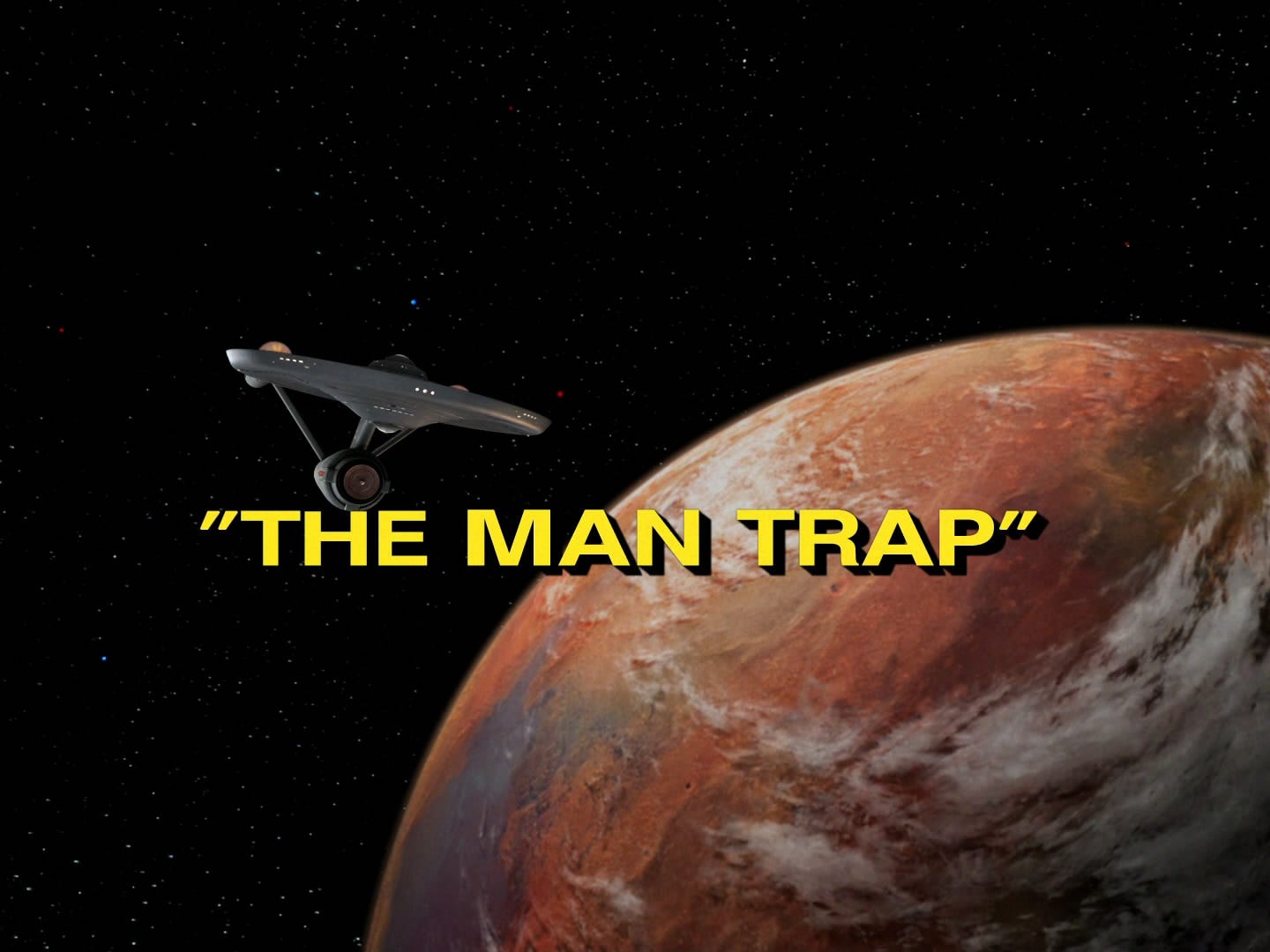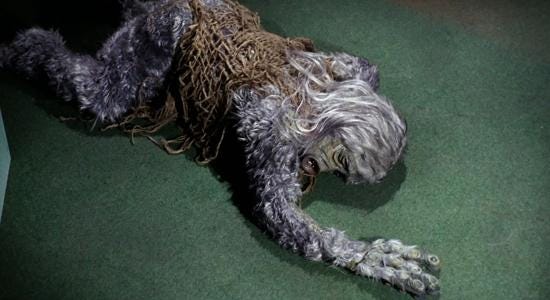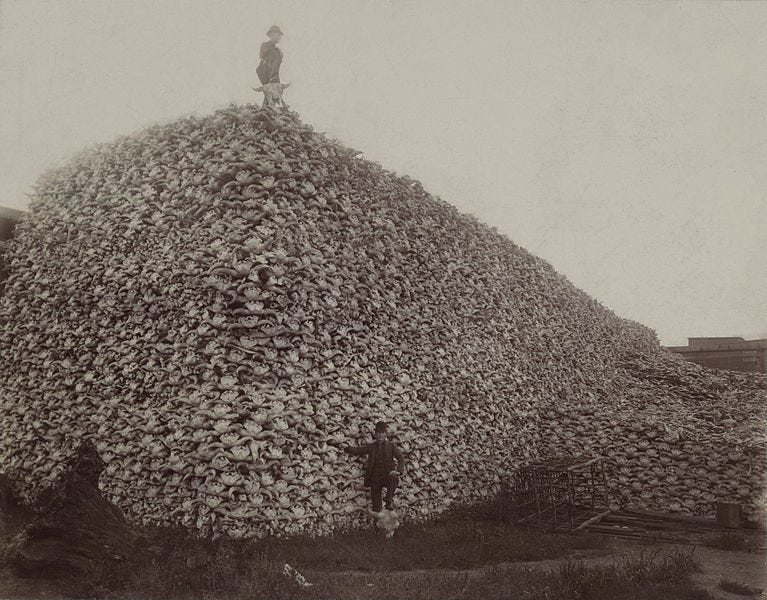A Single Herd Could Cover Three States!
"The Man Trap” was not meant to be the first episode of Star Trek. It was the sixth episode filmed and was considered a straightforward, quite literal “monster-of-the-week” affair. The show’s notably zig-zagging production timeline featured two full pilots filmed and multiple other ideas rejected. “The Man Trap” was none of these. Instead, NBC, Star Trek’s parent network, selected “The Man Trap” as the kickoff episode for reasons divorced from character introduction or scene setting. The network always favored “planet episodes” over “ship episodes.”1 For production reasons, it was simply not possible for the crew to feature a new planet every week. But Star Trek was sold as “Wagon Train to the stars,”2 and NBC wanted production to deliver on that promise.3 According to executive in charge of production Herb Solow, that left only two real contestants among finished episodes that could meet their air date: this one and “The Naked Time.”4 Associate producer Bob Justman says that once the planet episode mandate came down, there was no doubt “The Man Trap” would be picked, as it was “scarier and more exploitable than the others.”5 This decision was made over the heads of the production team, who thought the episode did not do as much as others to establish the show’s essential character dynamics.
While Justman now says NBC picked a good episode, it’s easy to see why he hesitated. “The Man Trap” is an odd beast.
The first moments of Star Trek audiences ever saw came without any introduction. An unknown captain’s log plays over the image of a strange saucer mounted on scaffolding as it soars through space. This captain, who is not initially named, says that his crew must perform a routine medical check on two archaeologists alone on an alien planet. However, one of them, Dr. Nancy Crater, is “that woman” in the past of his ship’s surgeon, Dr. McCoy. What the captain does not know is that Nancy Crater has been replaced by a shapeshifting intelligent creature with squid tentacles for hands that feeds exclusively on salt, regardless of whether that salt is in a human body or not.
Sandra Gimple, an actress, dancer, and stuntwoman, played the monster, which was designed by special effects man Wah Chang and created by Chang and costume designer Bill Theiss.
“The Man Trap” is effective at this straightforward horror plot. The monster, able to read thoughts and assume the shape of any person, swiftly kills four intrepid members of the U.S.S. Enterprise (RIP Privates Darnell, Green, Sturgeon, and Barnhart) by sucking the salt out of their bodies as it stows away on the ship. It accomplishes its infiltration, somewhat comically, by appearing as a parade of hot women (and notably, to Communications Officer Uhura, one hot man) depending on the observer’s individual taste. “The Man Trip,” it seems, is just horniness. Throughout this crisis, Captain Kirk demonstrates capable, intense leadership with an ease that conveys comfort in his position despite his clear understanding of its weight. If there’s one star from the structure of this episode, it’s William Shatner, who appears to have his character completely figured out from frame one. Kirk is introduced ribbing McCoy about picking some flowers with which to greet his old sweetheart , lovingly calls him “Bones”, teases him about Dr. Crater’s nickname for him "(“Plum”), and gets away with it all thanks to his understated good humor and clear affection for the crew. Kirk’s shift into downright indignancy upon the death of Private Darnell validates the whole previous portrayal. That duality is why he’s the Captain. Its simply a great performance.
After interrogating the male Dr. Crater, the crew realize that the monster is, functionally, an intelligent chameleon. Crater argues against killing the creature, as it is “like the buffalo,” the last of an intelligent species that has run out of salt on its home planet. However, the creature forces the crew’s hand by killing Crater and attacking Kirk. McCoy, previously drugged by the creature and haunted by his past love, ultimately overcomes the mental block of shooting the furry squid-yeti impersonating his old flame. Friendship wins out. The Enterprise sails on.
The monster, now called the “Salt Vampire” by fans, is like a vampire in more ways than one, complicating the thematic thrust of the episode.
Reviews at the time were somewhat positive, if dismissive, as they largely were throughout Star Trek’s first season. Cleveland Amory, writing a retrospective on season one for TV Guide, stated that Star Trek was best enjoyed as Captain Kirk commands in a later episode: “Face Front. Don’t Talk. Don’t Think. Don’t Breathe.”6 But this does our salt vampire, and writer George Clayton Johnson, a disservice.
In the main, this episode challenges to the Enterprise’s overall mission. As Crater says over and over, the creature is intelligent. It is the last of its kind. It is just doing what it needs to do to survive. The Enterprise is designed to seek out new life and new civilizations on a mission of peace and research. And yet, the creature must die. The crew of the Enterprise engage in a final extermination when McCoy pulls the trigger to save his friend. The creature wordlessly looks at McCoy, almost doglike, as it falls to the floor. There is a sympathy between them; the monster had never tried to kill McCoy (even once passing up the opportunity) perhaps out of a lingering loyalty from the thoughts of the now-deceased Dr. Nancy Crater. And thus, there is a tragedy in its death. “The Man Trap,” along with being horniness, is the last buffalo of dead planet. Who said not to think?
A massive pile of buffalo skulls from the height of the extermination movement in the 1870s. Buffalo herds were massive and would often interfere with railroad routes, causing railroad companies and western state governments to engage in mass culls. As an intended side effect, Native American tribes were deprived of a main food source and way of life. Thankfully, the extermination was unsuccessful.
Despite this, it is clear that the episode disagrees with Dr. Crater, the quasi-husband of this space “buffalo.” As Kirk says, buffalo were not murdering members of railroad crews. The monster continues to kill even after the crew leaves out salt as bait. At the risk of sounding too obvious, salt is an abundant element that doesn’t need to be drained from a human. The Enterprise has plenty of it; the monster is intelligent and could always just ask for a meal. No, the monster is not the last buffalo. The monster, not in spite of but because of its intelligence, is a moral actor that has done evil things, and its death is only a tragedy in that it made the wrong choices, not in that it did not have any choice at all. While the Enterprise must seek out new life, not all life is good. The moral frame of this utopian future is considerably grayed; the mission won’t be so simple. The show is going to be about these answers, since there are still these questions.
The episode ends as Kirk and Spock look out the front of the Enterprise:
“Something wrong, Captain?”
“I was thinking about the buffalo, Mister Spock.”
So am I. I’m thinking about how many species have gone extinct, and how many of them were not buffalo.
Stray Thoughts
Spock barely features in this episode. We learn he is a Science Officer and the second-in-command, but he’s largely kept out of the action. Famously, NBC was concerned that Spock’s “satanic” appearance would be off-putting to viewers and only reluctantly agreed not to cut him from the show. The network’s worry was so palpable that they even airbrushed his ears in promotional photos. Perhaps another reason “The Man Trap” was NBC’s pick was that the riskiest element of the show was largely backgrounded.
At one point, the monster speaks Swahili to Uhura as it attempts to seduce her. I wonder if this was the first time many Americans heard Swahili.
Buffalo are canonically extinct in Star Trek’s universe, but not in ours! I wonder if this was a genuine worry in the 1960s, it seems buffalo populations are relatively stable these days, if almost entirely domesticated.
This episode was directed by Marc Daniels, who would go on to direct more episodes of The Original Series than any other director.
Sulu is shown as an interested botanist. I think one thing that’s nice about this episode is that it gives each of its characters a little flavor, even the minor ones. Spock’s “logical” focus is challenged by his clear anger about the monster, for example. Little glimpses of what would later be called “canon.”
The background Enterprise crew is indeed rather multiracial and gender mixed. While the women’s costumes certainly aren’t all business, it is interesting to see that vision of the future live true to the show’s reputation.
Photo Credits
“The Man Trap” header: https://memory-alpha.fandom.com/wiki/The_Man_Trap_(episode)
Sandra Gimple in costume and the in-color Salt Vampire: https://www.startrek.com/article/catching-up-with-the-salt-vampire-sandra-gimpel
Buffalo skulls (and an interesting article to boot): https://www.smithsonianmag.com/history/where-the-buffalo-no-longer-roamed-3067904/
Herbert Solow and Robert Justman, Inside Star Trek: The Real Story, p.162
Id. at p. 17. Wagon Train was a hit show at the time that produced 284 episodes over 8 seasons. The show followed a single, large cast of characters as they journeyed through the American Old West from St. Louis to Sacramento. Each episode involved a different location and problems the group encountered along the way. https://www.imdb.com/title/tt0050073/
Id. at p. 198.
Id.
Id. at p. 163.
David Alexander, The Authorized Biography of Gene Roddenberry: Star Trek Creator, p. 258.








wowwww you really hit us with the famous buffalo pic. this was great. i didn't know that about people thinking spock was satanic, that's hilarious.
in my personal opinion, if you're watching the show correctly, every episode is a "ship" episode. but that's just me.
Once you've watched the first six episodes, let us know which you might have started the series with!